Rosalea’s Staycation Pt 1: A Day in the Park at Richmond, CA
Rosalea’s 2012 Staycation - Part 1: A Day in the Park at Richmond, CA
By Rosalea Barker
May
27, 2012
I read a great vacation planning tip in an Amtrak tweet recently: Decide how you want to feel on your vacation then go to the place that makes you feel that way. Figuring that “oblivious to all that’s wrong with the world” and “bed” were not going to hold up past the first 72 hours of my two-week vacation, I settled on the idea that I wanted to feel “relaxed”. Hawai’i maybe? Well, no, since it involves the antonym of “relax”: airports.
So here I am, staying at the Rosalea Residence Suites—where the staff are apparently on strike, since I have to make my own bed and clean up after myself. BUT it has been declared an alarm-clock-free zone, with no deadlines to meet or buses to catch unless I decide otherwise. Which, yesterday, I did and attended the opening day of the new visitor center at the Rosie the Riveter WWII Homefront National Historical Park in Richmond. It’s easily accessible by public transit—BART to Richmond, then the Marina Bay-direction AC Transit No. 74 bus, which terminates at Ford Point.
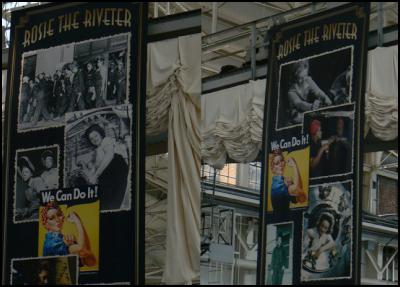
Click for big version.
Mashup of the two banners at the opening day reception at Ford Point.
Richmond is an East Bay city that figures most prominently in the local news for its high death rate from shootings and the residents’ battles with its largest corporate presence—Chevron’s oil refineries—over issues of air pollution. Recently, it scored a major victory over its East Bay neighbors, Berkeley and Oakland, by winning the bid to be the second campus for the Lawrence Berkeley National Laboratory. The city’s mayor, Gayle McLaughlin, is also the only Green Party mayor of such a large city.
Even before the US entered WWII, Richmond was predominantly working class because of the industries situated there, including a Ford assembly plant, which was switched over to assembling military vehicles when the war started. Long abandoned, the building has been renovated and now houses businesses like Sunpower, which produces solar power systems worldwide.
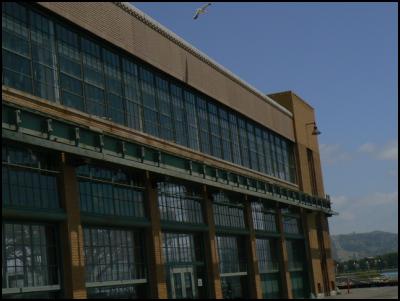
Click for big version.
Ford assembly plants looked much the same around the world—this one has a magnificent view of San Francisco Bay. The bridges visible in the photo below are the Gunmetal Grey western and eastern spans of the Bay Bridge linking Oakland to San Francisco, which were being built at the same time as that International Orange floozy linking San Francisco to the North Bay.
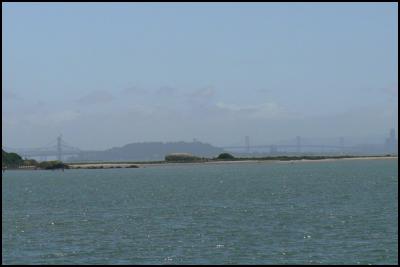
Click for big version.
Even before the United States’ entry into World War II, a huge influx of workers from all around the US came to Richmond because Henry Kaiser began production of “Liberty Ships” there in December 1940. In a three-year period, Richmond’s population went from 20,000 to 100,00, with workers taking turns sleeping in the beds rented out in shifts to match the round-the-clock schedule at the three Kaiser shipyards that operated during the war.
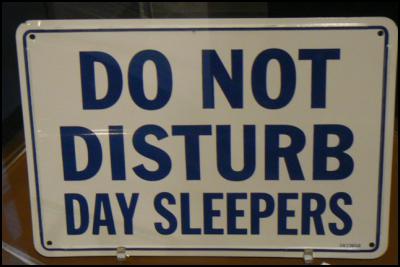
Click for big version.
A sign of those times.
Although the women who worked in the shipyards were better known as “Wendy the Welder”, Rosie the (airplane) Riveter is a more widely known icon because of WWII propaganda posters. The National Historic Park at Ford Point in Richmond, CA, pays tribute to all those who worked on the home front during WWII, and the artifacts reflect this. The banner below shows a secretary from Ford’s Willow Run hangar in Michigan demonstrating how to fold and wear the bandana forever associated with women doing war work in factories across the nation.
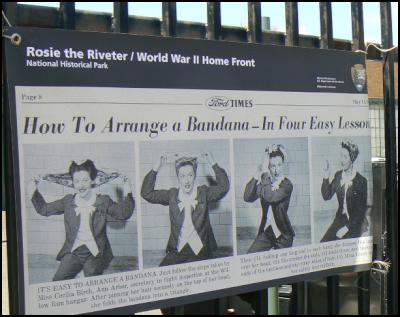
Click for big version.
A trail links the Visitor Center to the Rosie the Riveter Memorial on the site of Kaiser’s No. 2 Shipyard, and to several small parks also situated on Marina Bay. The trail is for pedestrians and cyclists, and the truly trail-hungry can continue east over a tidal marsh that is home to a variety of birds—marbled godwits, sandpipers, long-billed curlews. Its neighboring pools attract mallards, American widgeons, and green-winged teals. (Godwits! Mallard! TEAL! It’s so reminiscent of New Zealand!)
Nowhere, however does the National Park Service literature on the trail mention raccoons, so I was surprised to see a finger puppet of one in the Visitor Center store. I guess it is, after all, a National Park—albeit the only one in the US that the NPS doesn’t own, but instead operates with a number of community partners, like the Rosie the Riveter Trust—and National Parks are home to a host of critters.
I leave you, therefore, with Rosie the Raccoon, with which I shall embellish my middle finger before gesturing to anyone who says “It can’t be done.”
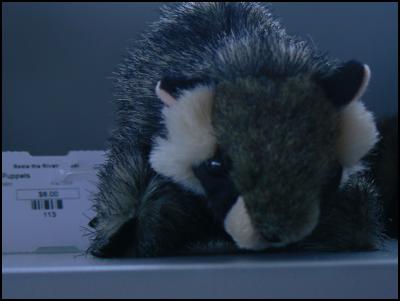
Click for big version.
--PEACE—
ENDS


 Gordon Campbell: On Why Leakers Are Essential To The Public Good
Gordon Campbell: On Why Leakers Are Essential To The Public Good Ramzy Baroud: Global Backlash - How The World Could Shift Israel's Gaza Strategy
Ramzy Baroud: Global Backlash - How The World Could Shift Israel's Gaza Strategy DC Harding: In The Spirit Of Natural Justice
DC Harding: In The Spirit Of Natural Justice Martin LeFevre - Meditations: Animal Encounters During Meditative States
Martin LeFevre - Meditations: Animal Encounters During Meditative States Ian Powell: Gisborne Hospital Senior Doctors Strike Highlights Important Health System Issues
Ian Powell: Gisborne Hospital Senior Doctors Strike Highlights Important Health System Issues Keith Rankin: Who, Neither Politician Nor Monarch, Executed 100,000 Civilians In A Single Night?
Keith Rankin: Who, Neither Politician Nor Monarch, Executed 100,000 Civilians In A Single Night?